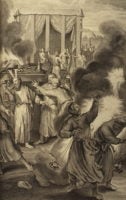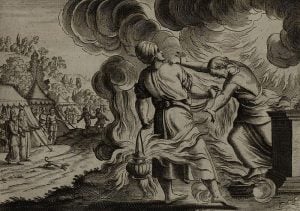Tzaraath, Black Holes, and Holographic Principle
By Alexander Poltorak Abstract This essay explores the profound connections between the biblical laws of tzaraath (Leviticus 13-14) and modern concepts of entropy and the
By Alexander Poltorak Abstract This essay explores the profound connections between the biblical laws of tzaraath (Leviticus 13-14) and modern concepts of entropy and the
By Alexander Poltorak Abstract The Torah portion of Shemini records the climactic eighth day of the Tabernacle’s dedication, the moment when divine fire finally descends.

And on the eighth day, the flesh of his foreskin shall be circumcised. Leviticus 12:3 In the Torah portion of Tazria, we are commanded to

The Torah portion Tzav describes a ritual performed by Moses in consecrating Aaron as the High Priest (Kohen Gadol) and his sons as priests (kohanim):

For the life of the flesh is in the blood.” (Leviticus 17:11) The word translated here as “life” in the Hebrew original is nefesh, i.e.,

And Nadab and Abihu, the sons of Aaron, took each of them his censer, and put fire therein, and laid incense thereon, and offered strange

And every meal-offering of thine shalt thou season with salt; neither shalt thou suffer the salt of the covenant of thy G‑d to be lacking

And all the tithe of the herd or the flock, whatsoever passeth under the rod, the tenth shall be holy unto the Lord.” (Leviticus 27:32)

And ye shall take you on the first day the fruit of goodly trees, branches of palm-trees, and boughs of thick trees, and willows of

And whosoever lieth carnally with a woman, that is a bondmaid, designated for a man, and not at all redeemed, nor was freedom given her;
In my post, “Ye Shall be Disentangled,” I suggested that the verse: “Ye shall be holy, for I, the Lord, your G‑d, am holy” (Levit.

And the Eternal spoke unto Moses, after the death of the two sons of Aaron, when they drew near before the Eternal and died. (Leviticus
In the Torah portion Emor (Leviticus 21:1–24:23), we are instructed to abstain from work every seventh day on Shabbat. Next week’s Torah portion, Behar, continues
Last week Torah portion, Emor, speaks about the prohibition of working on Shabbat. In fact, the Talmud enumerates precisely 39 categories of labor forbidden on

The blessings and the admonitions of Bechukotai (Leviticus 26:3–27:34) are viewed as the result of entanglement and disentanglement with G‑d respectively.
Ye shall be holy, for I, the Lord, your G‑d, am holy. Leviticus 19:2 This Torah portion begins with an astonishing statement: Speak unto all

And he shall take the two he goats, and place them before the Lord at the entrance to the Tent of Meeting. And Aaron shall

In the Torah portion Tazriah (Leviticus 13), the Schrödinger cat[1] gets leprosy. Well, it’s not really leprosy, it’s a mysterious supernatural disease called tzara’as, nowadays translated